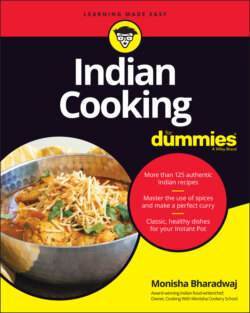Читать книгу Indian Cooking For Dummies - Monisha Bharadwaj - Страница 83
Must-have oils for an Indian kitchen
ОглавлениеVarious regions of India use different cooking oils based on what crops grow there. The West grows peanuts, whereas coconut trees abound in parts of the South. Local cuisines have come to be distinguished by the aroma of the cooking oil they use. In my kitchen, I have a few kinds of oil because I love cooking all kinds of regional Indian food.
You may not want to invest in several bottles of infrequently used oils, however, so I suggest stocking up on two or three that remain stable at high temperatures.
Many curries begin with the frying of spices, which need heat to split and release their aromatic oils. A stable oil, which is one that doesn’t easily react with oxygen to form free radicals, has a high smoke point. If an oil is heated beyond its smoke point, it decomposes and releases toxic fumes and can also get close to the point of catching fire.
Table 4-5 lists some common types of oil you may want to buy.
TABLE 4-5 Buying Cooking Oils
| Oil | Description |
|---|---|
| Canola | Called rapeseed oil in some countries, canola oil has a high smoke point. It can be used for frying and pan-frying and for everyday Indian cooking. |
| Coconut | In recent years, coconut oil has been hailed as a superfood in the West, but it has been used for centuries in South India. It’s high in saturated fat, though, so limit your use of it. |
| Corn | The high smoke point of corn oil makes it a good one for deep-frying with, and its neutral taste is good in curries. |
| Sunflower | Neutral tasting, sunflower oil will not add another layer of flavor to your curry. It also has a high smoke point, so it’s good for Indian cooking. It can be used for shallow or deep-frying. |
